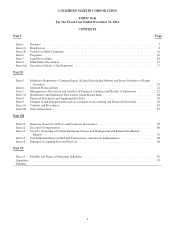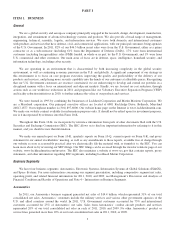Lockheed Martin 2011 Annual Report Download - page 20
Download and view the complete annual report
Please find page 20 of the 2011 Lockheed Martin annual report below. You can navigate through the pages in the report by either clicking on the pages listed below, or by using the keyword search tool below to find specific information within the annual report.otherwise. The amount of insurance coverage that we maintain may not be adequate to cover all claims or liabilities, and it is
not possible to obtain insurance to protect against all operational risks and liabilities.
Substantial claims resulting from an accident, failure of our products or services, or other incident, or liability arising
from our products and services in excess of any indemnity and our insurance coverage (or for which indemnity or insurance
is not available or not obtained) could adversely impact our financial condition, cash flows, or operating results. Any
accident, even if fully indemnified or insured, could negatively affect our reputation among our customers and the public,
and make it more difficult for us to compete effectively. It also could affect the cost and availability of adequate insurance in
the future.
Our earnings and margins may vary based on the mix of our contracts and programs, our performance, and our
ability to control costs.
Our earnings and margins may vary materially depending on the types of long-term government contracts undertaken,
the nature of the products produced or services performed under those contracts, the costs incurred in performing the work,
the achievement of other performance objectives, and the stage of performance at which the right to receive fees is finally
determined (particularly under award and incentive fee contracts). Changes in procurement policy favoring new, accelerated,
or more incentive-based fee arrangements or different award fee criteria or government proposals that indicate what our costs
should be may affect the predictability of our profit rates. Our customers are under pressure that may result in a change in
contract types earlier in program maturity or pursuit of non-traditional contract provisions in negotiation of contracts.
Our backlog includes a variety of contract types which are intended to address changing risk and reward profiles as a
program matures. Contract types include cost-reimbursable, fixed-price incentive, fixed-price, and time-and-materials
contracts. Contracts for development programs with complex design and technical challenges are typically cost-reimbursable.
Under cost-reimbursable contracts, we are reimbursed for allowable costs and paid a fee, which may be fixed or
performance-based. In these cases, the associated financial risks primarily relate to a reduction in fees, and the program could
be cancelled if cost, schedule, or technical performance issues arise.
Other contracts in backlog are for the transition from development to production (e.g., Low Rate Initial Production),
which includes the challenge of starting and stabilizing a manufacturing production and test line while the final design is
being validated. These generally are cost-reimbursable or fixed-price incentive contracts, although there is a current stated
U.S. Government preference for fixed-price incentive contracts. Under a fixed-price incentive contract, the allowable costs
incurred are eligible for reimbursement, but are subject to a cost-share limit which affects profitability. Changes resulting
from the ongoing development phase may need to be implemented on the production contracts, a concept referred to as
concurrency. The risks associated with estimating and recovering the potential cost of concurrency changes on LRIP
contracts may affect our earnings and cash flows. If our costs exceed the contract target cost or are not allowable under the
applicable regulations, we may not be able to obtain reimbursement for all costs and may have our fees reduced or
eliminated.
There are also contracts for production as well as operations and maintenance of the delivered products that have the
challenge of achieving a stable production and delivery rate, while maintaining operability of the product after delivery.
These contracts are mainly fixed-price, although some operations and maintenance contracts are time and materials-type.
Under fixed-price contracts, we receive a fixed price despite the actual costs we incur. We have to absorb any costs in excess
of the fixed price. Under time-and-materials contracts, we are paid for labor at negotiated hourly billing rates and for certain
expenses.
The failure to perform to customer expectations and contract requirements may result in reduced fees and affect our
financial performance in that period. Under each type of contract, if we are unable to control costs, our operating results
could be adversely affected, particularly if we are unable to justify an increase in contract value to our customers. Cost
overruns or the failure to perform on existing programs also may adversely affect our ability to retain existing programs and
win future contract awards.
If our subcontractors, suppliers, or teaming agreement or joint venture partners fail to perform their obligations, our
performance and our ability to win future business could be harmed.
Many of our contracts involve subcontracts or teaming arrangements with other companies upon which we rely to
perform a portion of the services that we must provide to our customers. We also sometimes bid on contracts through joint
ventures that award work through these entities, rather than through subcontract or teaming arrangements. There is a risk that
12
























